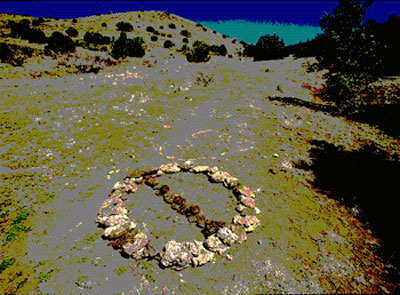
Coconino National Forest

Coconino National Forest
Circle in the Road. A broken bag
of silica sand beside the road was used to make this circle with the San
Francisco peaks in the background. The proposed expansion of the Snowbowl
ski resort on the west slope of the San Francisco peaks requires a 66 acre
clearcut in this very sensitive forest. The land is considered sacred by
Arizona American Indian tribes. Currently an EIS is being conducted. For
further information on protecting the San Francisco Peaks and the Coconino
National Forest contact the Flagstaff Activist Network: reg3@dana.ucc.nau.edu
or avb@ucc.nau.edu

Kaibab National Forest
Bone-cone Circle. Deer bones and pinecones make this simple circle beneath a lovely grove of ponderosas. According to a report by the Southwest Forest Alliance which was based on statistics from studies done by the Forest Service, southwestern forests have lost nearly all of their large trees. One hundred and twenty years of logging, grazing and fire suppression have wiped out most of the Southwestís old growth, leaving a landscape of stunted trees, dwindling grasses and eroding soil. The average diameter of trees in some Southwestern forests used to be as large as 24 inches at the turn of the century. Now, according to the Alliance, it has dropped to six inches.
For more information, contact the 50,000 member strong Southwest Forest
Alliance, POB 1940, Flagstaff AZ 86002. Phone 520.774.6154. Or, contact
the Grand Canyon Chapter
of the Sierra Club.

Zero Extraction Pie Circle. This is a 'posterized' version of a photo of sunbaked cow pies arranged in a circle on the China alotment; one of the most overgrazed regions in Prescott National Forest. The environmental impacts of grazing on our arid southwestern national forests are indisputable. Studies show that freshwater streams, arteries of life in these dry lands, are in the worst shape in recorded history. Wildlife pays a heavy price for livestock grazing. More than 150 fish and wildlife species already listed as endangered are imperiled by livestock grazing on western BLM and USFS lands. And just like we pay for the destruction of our forests, we subsidize ranchers with a give-away of an estimated $200 million a year in grazing permits. As if this weren't enough welfare in times of federal budget constraints, some members of Congress are trying to give public livestock grazing operators an even better deal!
Cattle operations on western public lands produce just 3% of our nation's beef. Private grazing lands could easily replace this percentage. It's time to set our sights on a Zero Extraction policy for all public lands.
To find out how you can help, contact the Prescott
National Forest Friends, POB 10642, Prescott, AZ 86304. (520) 776-1552.
Grazing acitivists periodically check the website below to get the latest
information on what's happening to end grazing on public lands:
http://www.neta.com/~jburgess.